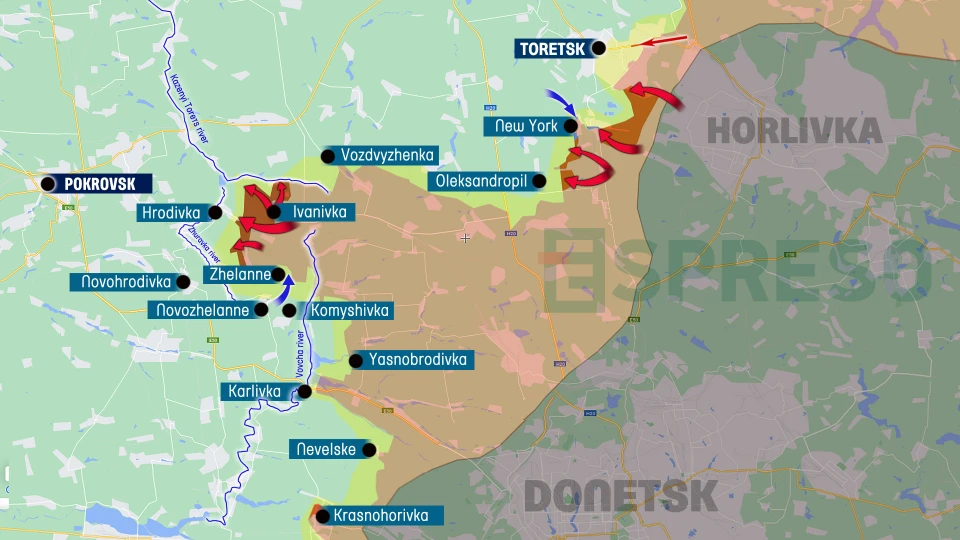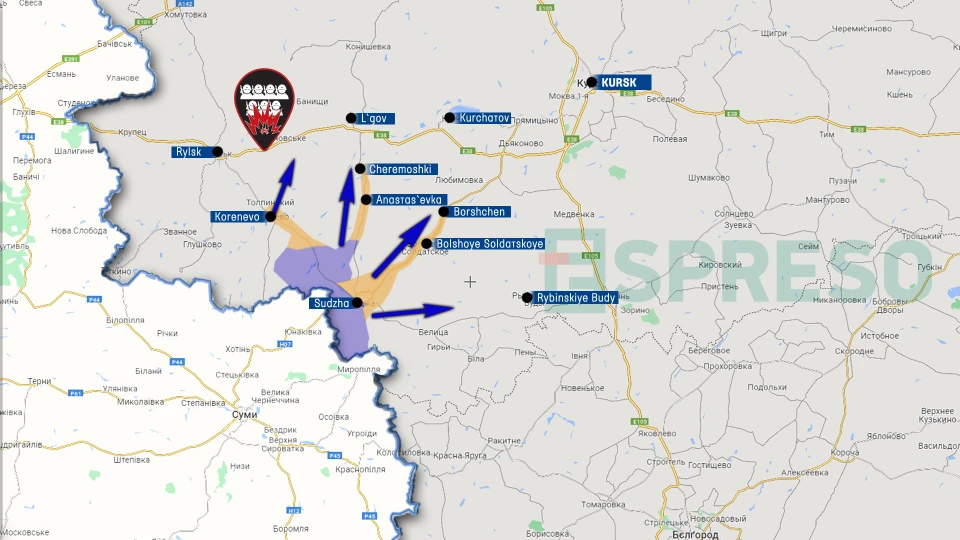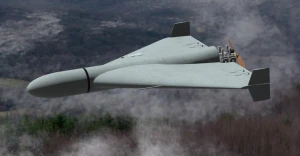
Russia maintains tactical edge in Donetsk region, reinforces troops in Kursk region – Serhiy Zgurets’ column
Reports indicate that Russia has amassed around 5,000 personnel in the Kursk region near Glushkovsky district. In the directions of Lgov and Rylsk, this figure rises to about 8,000, while east of Sudzha, it reaches up to 11,000. Overall, Russia's military buildup in these areas now totals nearly 25,000 troops
Donetsk region
Let’s kick off this column with footage released by Ukraine’s Air Force. These are strikes with guided aerial bombs targeting Russian equipment and personnel in the Donetsk direction.
Ukraine's Air Force Commander General Mykola Oleschuk noted that the tactical aviation was impressive. And indeed, it is. But it’s also true that in the Donetsk region — especially in the Pokrovsk and Toretsk directions — Russia currently holds the tactical upper hand. Russian troops are slowly pushing forward in the Pokrovsk direction, particularly near Novohrodivka and Selydove, and are engaging in combat in Hrodivka.

There’s also movement in Mykolaivka, which sits midway on the route from Pokrovsk to Karlivka. This is concerning because the Novohrodivka-Hrodivka line is critical for Ukraine, marking the start of an important agglomeration. I believe Russia’s advance will be halted, provided Ukraine musters the necessary forces and resources.
The situation in the village of New York is equally tense. Russian troops have pushed through part of the settlement and are now moving toward Nelipivka. Some Western media have reported that this town has fallen to Russian forces, though Ukrainian military insists that the Ukrainian Armed Forces still control at least 20% of it. We’re awaiting official confirmation. It's tough dealing with Russia in this type of confrontation. That’s why Ukraine's military-political leadership is banking on asymmetric moves — opening up new offensive lines, including in the Kursk direction.
Kursk direction
On August 20, Ukrainian Commander-in-Chief Oleksandr Syrskyi shared specific details regarding the direction and purpose of the operation. He stated that the operation aims to establish a security zone, halt shelling from Russian territory, and outmaneuver Russia. To achieve this, the Ukrainian Defense Forces are now executing an offensive defense in the Kursk direction.

Syrskyi reported that Ukrainian forces have advanced 28 to 35 km deep, covering a total width of about 60 km. The Armed Forces of Ukraine (AFU) have captured 1,263 km² of Russian territory and secured control over 93 settlements. In response, Russian troops are conducting a maneuvering defense, attempting to prevent further Ukrainian advancement.
This raises the question: What is the total power of Russian forces concentrated in the Kursk direction?
By integrating data from various sources, it's estimated that in the western sector, near the Glushkovsky district, up to 5,000 Russian personnel are concentrated. In the central zone, towards Lgov and Rylsk, about 8,000 Russian troops from various units, including operational reserves, are positioned. The eastern sector, east of Sudzha, hosts the largest concentration, with up to 11,000 Russian personnel. Altogether, Russia has built up a force of around 25,000 troops across these areas.
As for Ukraine's forces, the exact numbers remain undisclosed. Western media estimate Ukrainian personnel at around 10,000, as reported by The Wall Street Journal. On August 19, The Economist suggested that our group had grown to 20,000. Meanwhile, Russian sources claim up to 50,000 Ukrainian troops — likely an exaggeration born of fear.
It's clear that actions in this direction are crucial for the Ukrainian Forces. Equally important is maintaining the balance of forces and addressing the needs of the AFU on other fronts, particularly in the critical Pokrovsk and Toretsk directions.
The situation is dynamic, and significant developments are imminent. It’s also worth noting that Ukraine's offensive marks the first time since World War II that military units from another country have entered Russian territory.
On the foreign media’s reaction to the Kursk operation
Many foreign outlets are focusing heavily on evaluating the tactical moves of the Ukrainian Armed Forces. However, over time, these reports overshadow other critical aspects, directions, and fragments.
Hryhoriy Lyubovets, a leading researcher at the Scientific Research Center of the Military Institute of Taras Shevchenko National University of Kyiv, discussed the Ukrainian Armed Forces' actions in the Kursk region and the foreign media's response. He emphasized the need for a paradigm shift in how we perceive and present information. According to him, Ukraine is in a unique situation where information must become a weapon of action. We’re talking about 93 settlements captured in the Kursk region, but the information comes only from a few of them. Ninety-three is significant. Ukraine is operating on a local level where what happens locally can often have global repercussions. So, why aren’t Ukraine's foreign partners noticing? Because it’s a major challenge for them too.
Lyubovets mentioned CNN, which barely crossed the border on the first day of the Kursk operation, filming their pieces just a meter away from what’s internationally recognized as the Russian Federation’s border. Italian journalists did cover the story, but they quickly left after receiving direct threats from Russia. We must emphasize that Ukraine isn't just engaging in "offensive defense" — a term that needs more attention. Since 2014, Putin's Russia has forfeited the right to call itself non-belligerent; they've been attacking Ukraine since then. So, Ukraine has been defending itself since 2014, and any Russian soldier or personnel working at a Russian military facility who is neutralized is the destruction of the enemy. We need to say it. Ukraine's communications and content should be built and developed as a dynamic, large-scale offensive strategy, pushing its narrative onto the global stage.
In the Kursk region, we witness a clear example of the depopulation of social groups — no community, no social partnership, no interaction at the local level. Therefore, Ukraine must report not just from Sudzha but from every settlement in the Kursk region to highlight how Putin has driven people to a state of isolation, reducing them to parts of a corporate entity called "Putin's regime." This is a technique where the central power isolates each individual, ensuring they don't have interest groups, friends, or anyone who might support an uprising against the regime. For Putinists, any protest spells the end of their power because the Russian Federation isn't a state — it's a regime. It's challenging to convey this to Ukraine's partners, but we must.
Lyubovets concluded that Putinism is terrifying because of its impunity, which has persisted from the Kremlin for over 100 years — from the Holodomor in Ukraine to the military operations in 2014, which continue today. All without consequence. Now, talks about negotiations are resurfacing, and some are even discussing peace without victory. But we must insist on the victory of the civilized world over Putin's genocidal regime. We must rally the world against a regime that isn’t just destroying Ukraine or Europe but is dismantling the world order and the UN charter.
- News














































